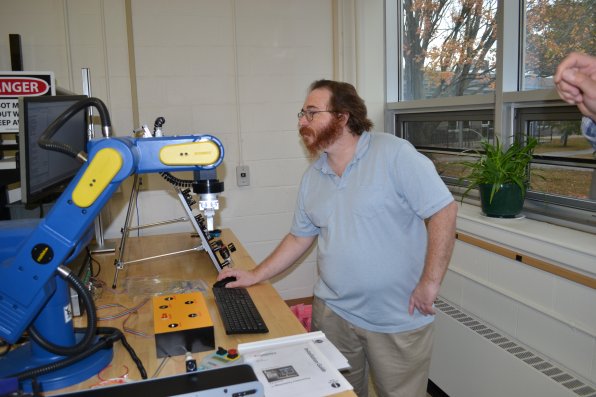Like that bodybuilder in the Planet Fitness commercial, the robots at NHTI pick things up and put them down.
But, as you’ll soon learn, there’s a lot more behind the SCORBOT-ER 9PRO than just bringing a few bulging muscles to the table. That’s because these robots (or any, for that fact) actually don’t need ripped biceps or triceps – mostly since it can only pick up 8 pounds at a time and usually only moves small blue blocks a short distance.
The real muscles necessary to run these machines are securely inside the heads of the robotics and automation engineering students that operate them. Without the college programmers mapping out the SCORBOT’s every move, it would just be another really expensive paper weight. And that was not the intention when Concord’s Community College introduced the program last year after receiving a U.S. Department of Labor, Employment & Training Administration TAACCCT Grant. The grant, which gave $1.5 million to NHTI and $20 million total to six higher education facilities in the state, paid for the start-up advanced manufacturing program that will see the first four graduates strut across the stage this May.
“They are the brave souls that started the program,” said professor and program coordinator Joe Cunningham.
It paid for the automation lab and all the bells and whistles it contains, including the small fleet of SCORBOTs, as well as the computers and programs that make the mechanical version of that large gentleman in the aforementioned TV spot move with relative ease.
The four expected graduates this year and the 10 more who are in the first year of the program will have a choice when they finish at NHTI.
“They can go out into the industry or go on to get their bachelor’s degree,” Cunningham said. “We’re trying to provide the skills that employers need. It’s a growing field. There are lots of jobs out there.”
And if they do decide to enter the workforce upon graduation, Cunningham sees plenty of opportunities right here in New Hampshire to get a good paying job.
“In the real world, there’s a lot of ways to use automation,” Cunningham said. “And believe it or not, there are a lot of companies that do it.”
A total of 73 credit hours is needed to graduate from NHTI with a degree in robotics and automation engineering, and if you plan on becoming part of the third class, we hope you like math and science.
Year one is spent learning in basic engineering courses like electric circuits, engineering design, introduction to programming and integrated circuits and interfacing, as well as other general classes. It’s also when you take the first major specific course – machine tools and CNC machines. The second year is when things get really intense with PLC programming, robotics & automation I and – you guessed it – robotics & automation II.
“You’re trying to program for real world situations,” said second year student Patrick Lizer. “And the educational software teaches you how.”
But for all of you who won’t understand the engineering jargon (like us), don’t worry, we’re here to put it in more layman’s terms. The students use the computer software to create a program that instructs the robot, which is just an arm, to open and close its jaws and move along an X, Y, or Z plane. In the end, the robot will pick up those blue blocks and move them from the holder to a rectangle filled with sensors. The sensors, along with the programming lingo, will help determine the next step. There’s a lot more that goes into it, but you get the gist. And if not, just check out the show How It’s Made on the Science Channel. When in doubt, always refer to your television.
“What we like to do here is learn by doing,” Cunningham said. “In the educational world that’s the best way to learn.”
And while learning this stuff through lecture and reading is all you would need to induce a nice afternoon nap, this stuff is all done by trial and error.
“It’s a lot of hands on, taking the time to fiddle with things,” said second year student Ben Wakeman.
The goal is to see the program grow and have all that $1.5 million equipment put to good use.
“What we’re trying to do is get the word out that we have this great program,” Cunningham said.
Guess that’s where we come in.









